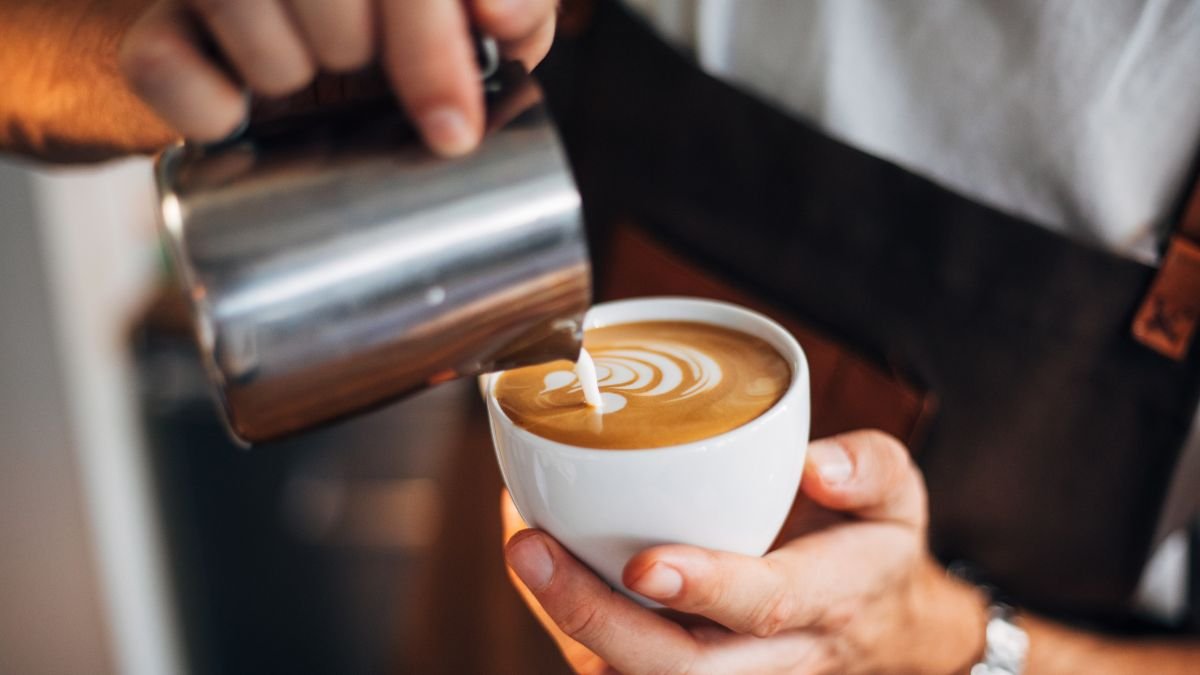A latte is one of the most beloved coffee drinks worldwide, known for its creamy texture and balanced flavors. Whether you’re a coffee enthusiast or just beginning your barista journey, learning how to craft a perfect latte is a must. A great latte combines the rich, bold taste of espresso with the smoothness of steamed milk, topped with a velvety foam.
In this beginner’s guide, we’ll walk you through the steps to make the perfect latte, share tips for achieving a creamy texture, and teach you how to create latte art to impress your friends and family.
1. Understanding the Latte Components
Before jumping into the brewing process, let’s first break down the components that make up a perfect latte:
- Espresso: A concentrated shot of coffee brewed under high pressure. The espresso provides the rich, bold base for your latte.
- Steamed Milk: The milk is steamed to create a creamy texture that complements the espresso’s strong flavor. The milk should be frothed to a velvety consistency, with microfoam for that smooth, luxurious mouthfeel.
- Foam: A thin layer of frothed milk sits on top of the latte, giving it that signature latte texture and appearance.
To make a latte, you’ll need two key tools: an espresso machine and a steam wand for frothing the milk.
2. What You’ll Need to Make the Perfect Latte
Here’s a simple list of the equipment and ingredients you’ll need:
- Espresso Machine: You can make a latte with a semi-automatic, automatic, or manual espresso machine. The machine should have a steam wand for frothing the milk.
- Freshly Ground Coffee: High-quality, freshly ground espresso beans will make a noticeable difference in the taste of your latte.
- Milk: Whole milk is traditionally used for lattes because it produces a creamier texture. However, you can use non-dairy milk like almond, oat, or soy milk, depending on your preference.
- Milk Frothing Pitcher: A stainless steel pitcher is best for frothing milk. It should have a spout for pouring and creating latte art.
- Coffee Scale (Optional): A scale can help you measure the exact amount of coffee and water for your espresso shot.
3. Step-by-Step Instructions for Brewing a Perfect Latte
3.1 Step 1: Brew the Espresso
Making a latte starts with pulling a perfect shot of espresso. Here’s how to do it:
- Grind the Coffee: Start by grinding your coffee beans to a fine consistency. You’ll need about 18 grams of coffee for a double shot of espresso.
- Tamp the Coffee: Place the ground coffee into the portafilter, and use a tamper to press it down evenly. Apply around 30 pounds of pressure to ensure a uniform, compact puck.
- Brew the Espresso: Lock the portafilter into the espresso machine, and start the extraction. A properly pulled shot should take about 25 to 30 seconds to extract, producing a rich, dark espresso with a thick layer of crema on top.
3.2 Step 2: Steam the Milk
Now, let’s move on to steaming the milk. This step is crucial to achieving that creamy, smooth texture:
- Fill the Pitcher: Pour about 6 to 8 ounces of milk into your milk frothing pitcher. Don’t overfill the pitcher, as the milk will expand when frothed.
- Position the Steam Wand: Submerge the steam wand just below the surface of the milk. Position the wand at an angle to create a whirlpool effect, which helps incorporate air into the milk for frothing.
- Steaming the Milk: Turn on the steam wand and let the milk froth. As the milk heats up, you should hear a gentle hissing sound. Keep the steam wand near the surface to create microfoam, and lower the wand deeper into the milk to heat it. Aim for a milk temperature of around 150°F (65°C).
- Check the Texture: Once the milk is steamed, it should have a velvety, creamy texture, with small bubbles and a silky appearance. The milk should flow like liquid silk and have a smooth consistency.
3.3 Step 3: Pour the Latte
The final step is combining the espresso and the steamed milk. The art of pouring is what makes the latte special!
- Pour the Espresso: Pour the brewed espresso into your cup, making sure the crema stays on top.
- Add the Steamed Milk: Slowly pour the steamed milk into the cup, starting from the center and moving outward. Use a gentle pour, allowing the milk to mix with the espresso.
- Create Latte Art (Optional): To create simple latte art, hold the pitcher close to the cup as you pour the milk, and use a back-and-forth motion to form a heart or rosette pattern. You can also practice pouring more intricate designs as you gain confidence.
3.4 Step 4: Serve and Enjoy
Your latte should have a beautiful, velvety foam on top, with a smooth blend of espresso and milk underneath. Serve it immediately, and enjoy the creamy, comforting flavors.
4. Tips for Perfecting Your Latte
Making a great latte takes practice, but there are a few tips that can help you get closer to perfection:
- Use Freshly Ground Coffee: Always grind your coffee just before brewing to ensure maximum freshness and flavor. Invest in a good-quality burr grinder for consistent grinds.
- Froth Milk Just Right: Be careful not to over-froth the milk. It should have a creamy, silky texture, not too bubbly or frothy. If the milk looks like it’s turning into foam, stop steaming before it becomes too airy.
- Experiment with Milk Alternatives: If you prefer dairy-free options, oat milk and almond milk are great alternatives. Oat milk, in particular, froths well and creates a smooth texture similar to whole milk.
- Master the Pouring Technique: Latte art can take time to master, but don’t be discouraged! Start with simple hearts or rosettas, and practice to improve your technique.
5. Common Latte Mistakes and How to Avoid Them
Here are a few common mistakes beginner baristas make when making lattes and how to fix them:
5.1 Weak Espresso
If your espresso tastes weak or watery, it could be due to under-extraction. Ensure you’re using the right grind size (fine), tamping properly, and extracting for the right amount of time (25-30 seconds).
5.2 Over-Frothed Milk
Milk that’s too foamy or bubbly can result in a poor texture. Always aim for microfoam, which is silky and smooth, with no large bubbles. Practice steaming the milk at a gentle pace to achieve the right consistency.
5.3 Incorrect Milk Temperature
If the milk is too hot (above 160°F), it will lose its sweetness and become scalded. If it’s too cold (under 140°F), the milk won’t have the smooth, creamy texture you’re looking for. Use a thermometer to ensure the right temperature range.
6. Conclusion: Mastering the Latte
Making the perfect latte takes time and practice, but once you’ve mastered the steps, you’ll be able to create a beautifully balanced coffee drink that rivals your favorite café. By paying attention to the key components—freshly brewed espresso, steamed milk, and the perfect pour—you’ll soon be crafting lattes like a professional barista.
With a little patience and a lot of practice, you’ll be able to enjoy a delicious, creamy latte every time.
Agora que o artigo está pronto, vou criar a imagem correspondente!Iniciando
Perguntar ao ChatGPT

I’m an economist with 15 years of experience in strategic planning and a lifelong passion for wellness and natural living. As a self-learner, I created Herbalife Balance to share insights on healthy eating, mindful habits, and an active lifestyle. Tennis enthusiast and nature lover, I believe in balance as a path to well-being. Through this blog, I help others live healthier, more conscious lives.

